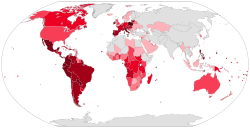
Back الرومانية الكاثوليكية في البرازيل Arabic Římskokatolická církev v Brazílii Czech Römisch-katholische Kirche in Brasilien German Katolika brazila Eklezio Esperanto Iglesia católica en Brasil Spanish Kategória:Katolikus egyház Brazíliában Hungarian Gereja Katolik di Brasil ID Chiesa cattolica in Brasile Italian Katholieke Kerk in Brazilië Dutch Igreja Católica no Brasil Portuguese
Catholic Church in Brazil | |
|---|---|
| Igreja Católica no Brasil | |
 The Basilica of the National Shrine of Our Lady of Aparecida in Aparecida. It's the second largest Catholic church in the world, after St. Peter's Basilica in Vatican City. | |
| Type | National polity |
| Classification | Catholic |
| Orientation | Latin |
| Scripture | Bible |
| Theology | Catholic theology |
| Polity | Episcopal |
| Governance | CNBB |
| Pope | Leo XIV |
| President | Walmor Oliveira de Azevedo |
| Primate | Sérgio da Rocha |
| Region | Brazil |
| Language | Portuguese, Latin |
| Headquarters | Brasília |
| Origin | c 1500 Colonial Brazil, Portuguese Empire |
| Separations | Brazilian Catholic Apostolic Church |
| Members | 119 million |
| Official website | CNBB |
| Part of a series on the |
| Catholic Church by country |
|---|
 |
|
|
The Brazilian Catholic Church, or Catholic Church in Brazil, is part of the worldwide Catholic Church, under the spiritual leadership of the Pope in Rome, and the influential National Conference of Bishops of Brazil (Portuguese: Conferência Nacional dos Bispos do Brasil - CNBB), composed of over 400 primary and auxiliary bishops and archbishops. There are 44 ecclesiastical provinces, which have 275 dioceses, eparchies, ordinariates, and territorial prelatures in Brazil. The primate of Brazil is Dom Sérgio da Rocha.
The Catholic Church is the largest denomination in the country, where 119 million people, or 56.75% of the Brazilian population, were self-declared Catholics in 2022.[1] These figures made Brazil the single country with the largest Catholic community in the world.[2][3][4]
According to a 2014 Pew Research Center study, 81% of Brazil's population was raised Catholic, but only 61% identified as Catholic in that year, a difference of 20 percentage points. One of the challenges faced by the Catholic Church in Brazil is the loss of adherents to Protestant churches and to irreligion.[5] The 2022 Brazilian census found that 56.7% of Brazilians identified as Catholic, a decrease of 8.4 percentage points from 2010, when 65.1% of the population aged 10 and older identified as Catholic. During the same period, Protestants increased from 21.6% to 26.9%.[6] In 1991, 83.34% of Brazilians identified as Catholics.[7] In a Datafolha survey conducted at the end of 2024, approximately 50% of the surveyed population identified as Catholic, while 25% identified as Protestant.[8]
- ^ "Censo 2022: católicos seguem em queda; evangélicos e sem religião crescem no país". IBGE. Retrieved 6 June 2025.
- ^ "Factfile: Roman Catholics around the world". BBC. 1 April 2005
- ^ Country Studies. "Brazil - Roman Catholicism". source: Rex A. Hudson, ed. Brazil: A Country Study. Washington: GPO for the Library of Congress, 1997.
- ^ Scalon, Maria Celi. "Catholics and Protestants in Brazil". America Magazine. 18 August 2003.
- ^ "Religion in Latin America: Widespread Change in a Historically Catholic Region". Pew Research Center. 13 November 2014. Retrieved 22 August 2016.
- ^ "Census 2022: Catholics continue to decline; evangelicals and non-religious grow in Brazil". IBGE. 2023. Retrieved 17 June 2025.
- ^ Cite error: The named reference
FGV1was invoked but never defined (see the help page). - ^ "Pope dies: see an overview of the Catholic Church". G1 (in Brazilian Portuguese). 21 April 2025. Retrieved 22 April 2025.